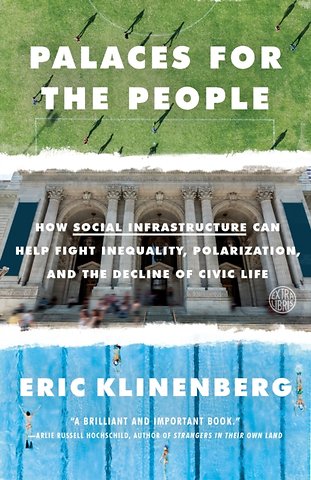Palaces for the People
How Social Infrastructure Can Help Fight Inequality, Polarization, and the Decline of Civic Life
Ingenaaid Engels 2019 1e druk 9781524761172Samenvatting
Americans are sorting themselves along race, class, and political lines, leading to a polarization we have not seen since the Civil War. In 'Palaces for the People: How Social Infrastructure Can Help Fight Inequality, Polarization, and the Decline of Civic Life' (Crown; September 11, 2018) renowned sociologist and #1 New York Times bestselling author Eric Klinenberg shows how we can find common purpose through social infrastructure. This provocative book argues that the resilience of our communities rests not on shared values but on shared spaces capable of fostering crucial, sometimes even life-saving connections among us. Klinenberg explains that today’s most pressing issues—crime, education, the opioid crisis, and climate change—can all be addressed with place-based policies, and shows examples of how such policies have been put into effect with great success.
Klinenberg is a professor of sociology and the director of the Institute for Public Knowledge at New York University. He coined the term “social infrastructure” to describe the libraries, day-care centers, bookstores, coffee shops, and community gardens that shape our face-to-face interactions, and he has been exploring it for decades—ever since his landmark study of Chicago during the 1995 heat wave. He was the research director for the Obama administration’s Rebuild by Design project, where he worked to integrate social infrastructure into post–Hurricane Sandy rebuilding plans. In PALACES FOR THE PEOPLE, he applies this deep knowledge, stemming from years of both research and application, to diverse communities and challenges around the globe—from Singapore to Brazil and from East New York to Silicon Valley—to show how interactive physical spaces are combating some of the most profound problems of our time.
Public institutions, such as libraries, schools, playgrounds, parks, athletic fields, and swimming pools are all vital parts of social infrastructure. So are churches and synagogues, flea markets, and corner diners. Places where people can gather and linger encourage the formation of social bonds and promote interaction across group lines, and if our democracy is going to thrive, we need more of them. Investing in social infrastructure is just as urgent as investing in conventional hard infrastructure like bridges, levees, and airports. Often, we can strengthen both simultaneously, establishing vital social arteries that are also “palaces for the people,” to borrow the phrase Andrew Carnegie used to describe the 2,500 grand libraries that he built around the world.
Specificaties
Lezersrecensies
Anderen die dit boek kochten, kochten ook
Rubrieken
- advisering
- algemeen management
- coaching en trainen
- communicatie en media
- economie
- financieel management
- inkoop en logistiek
- internet en social media
- it-management / ict
- juridisch
- leiderschap
- marketing
- mens en maatschappij
- non-profit
- ondernemen
- organisatiekunde
- personal finance
- personeelsmanagement
- persoonlijke effectiviteit
- projectmanagement
- psychologie
- reclame en verkoop
- strategisch management
- verandermanagement
- werk en loopbaan







